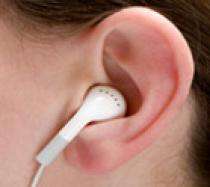Probing Question: Can deafness be cured?

The New Orleans Saints won the Superbowl in February, and the crowd roared. Quarterback Drew Brees brought his one-year-old son to the field to experience the celebration-muffled through an enormous pair of headphones. Brees protected little Baylen's ears because he knows that repeated exposure to loud noise leads to hearing loss. But what if you're older and already hard of hearing? Can deafness be cured?
"There's promise for a cure in the future," said Judith Creuz, a clinical audiologist at Penn State, "but it's not there yet."
When we listen to a conversation or hear music, sounds are transmitted to the eardrum, through the middle ear, then to the inner ear where the auditory nerve picks up the signals and sends them to the brain. Said Creuz, accidents that injure the eardrum, middle ear, or auditory nerve can cause deafness, but the most common cause of deafness involves the cochlea, in the inner ear. This snail-shaped organ contains hair cells that respond to different pitches of sound. "These hair cells are easily damaged," she explains.
Among the culprits are infections and certain drugs, including some of those used for cancer chemotherapy. Deafness also can be genetic, or can result from hair cell damage in utero. "But noise exposure, such as to loud music or industrial noise, is the cause of much hearing loss and later deafness," warned Creuz, adding that 39 million Americans have some degree of hearing loss. Many students "play iPods for many hours at a time, at levels that would be illegal if it was industrial noise," she pointed out. "This is causing hearing loss in younger and younger people."
Current treatments depend on the patient. A person who still has some residual hearing can be assisted with a hearing aid that amplifies sound, noted Creuz. However, those who are completely deaf cannot detect sound no matter how much it is amplified, so hearing aids are not an option. These people might be candidates for cochlear implants, she said. "This is a surgical intervention in which an electrode array is put right into the cochlea. Instead of hair cells responding to incoming sound, the implant creates an electrical impulse that goes directly to the auditory nerve and the brain, bypassing the hair cells." The patient then must undergo extensive post-implant therapy to learn to interpret those signals. "It's not really a cure," Creuz acknowledged. "The person is still deaf."
A true cure may be on the horizon, according to British researchers who made headlines last year by showing that stem cells could generate hair cells-at least in a Petri dish. But any cure based on stem cells is at least 10 years away, the researchers predicted.
Another promising avenue, said Creuz, is research on birds. "Unlike other animals, birds naturally regenerate hair cells," she explained. Figuring out how they do it, the theory goes, might teach us how to make our own. Until we do have a cure, Creuz emphasized, "the main thing is to prevent hearing loss." Use ear protection where appropriate, like little Baylen Brees. "And don't play those iPods too loudly," she said. "Work on keeping the hearing you have."














